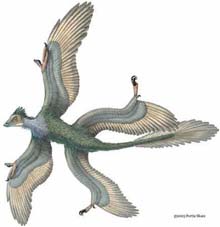Topic: - on February 23, 2003 at 1:26:47 AM CET
Europa drohen neue Flutkatastrophen
Wenn die Erderwärmung anhält, stehen Europa zwar insgesamt trockenere Sommer bevor. Dennoch könnten sich, so neue Berechnungen, die heftigen Regenfälle häufen - und damit auch die Überschwemmungen.
... Link (0 comments) ... Comment
Topic: - on February 23, 2003 at 1:20:48 AM CET
Einschlag auf dem Mond: Amateur hatte Recht
Fast 50 Jahre lang wurde die Annahme eines Amateur-Astronomen, dass ein gewaltiger Asteroid auf dem Mond aufschlug, von der Fachwelt als "Stuarts Ereignis" belächelt. Jetzt wurden seine Angaben bestätigt.
... Link (0 comments) ... Comment
Topic: - on February 20, 2003 at 6:34:51 PM CET
Glow-in-dark bug strikes
A BACTERIA which glows in the dark and shares genes with the bubonic plague has caused a series of unexplained infections along Australia's east coast.
The photorhabdus bacteria, first identified in an 11-year-old Melbourne girl in 1994, causes excruciatingly painful ulcers and abscesses.

¬> News Limited ¬> avi
... Link (0 comments) ... Comment
Topic: - on February 17, 2003 at 2:52:20 AM CET
Graffiti Space Trap Tested
Psssst, wanna catch a tagger?
Satellites and super-sensitive sensors are now tuned to the sibilant hiss of spray cans in a space-age effort to eradicate one of the oldest and most persistent urban problems -- graffiti.
TaggerTrap, a graffiti eradication system being tested in several California cities, uses global positioning system technology, cell phones and sensors that recognize the ultrasonic pitch of spray cans to alert police when vandals begin their work, representatives said.
... Link (0 comments) ... Comment
Topic: - on February 17, 2003 at 2:43:26 AM CET
The next tech toy: X-ray cameras
Developers predict consumer version could hit market in five years. Voyeurs take note: a portable, cheap camera that can see through objects and clothing may be available for sale to common folk in as little as five years, say British-based space researchers.
The camera, built by a European Space Agency-funded team working at a lab in central England, could one day be used to find skin cancer or hidden weapons, reveal wounds beneath animal fur or bandages, spot forged works of art, even pierce through fog.
¬> Canada
... Link (0 comments) ... Comment
Topic: - on February 16, 2003 at 6:52:30 PM CET
No time left to lose
Scientists are developing a new generation of atomic clocks which will be so accurate they will have lost only about a second by the time the world ends a few billion years from now.
The clock's technology will be used in telecommunications and experiments testing fundamental theories in physics and in probing human diseases.
... Link (0 comments) ... Comment
Topic: - on February 15, 2003 at 11:11:49 PM CET
Biology to make mini machines
factory machines, but by living cells such as bacteria.
That at least is the vision which has been outlined by scientists speaking at the American Association for the Advancement of Science annual meeting in Denver.

¬> BBC
... Link (0 comments) ... Comment
Topic: - on February 15, 2003 at 10:32:24 PM CET
Dolly the sheep clone dies young
Dolly the sheep, who became famous as the first mammal to be cloned from an adult cell, has died.
The news was confirmed on Friday by the Roslin Institute, the Scottish research centre which created her.
... Link (0 comments) ... Comment
Topic: - on February 6, 2003 at 11:23:37 AM CET
Mammut Park
Mammut vor Klonung
Russische Forscher wollen das Eiszeit-Ungetüm aus "bedingt lebendigen" Zellen wieder "auferstehen" lassen.
... Link (0 comments) ... Comment
Topic: - on February 6, 2003 at 11:21:10 AM CET
Fischwahnsinn?
Problem der Symptom-Erkennung: Wie verhält sich ein wahnsinniger Fisch?
... Link (0 comments) ... Comment
Topic: - on January 24, 2003 at 1:35:50 PM CET
325-Million-Year-Old Fossil Found in Ark
University of Arkansas students unearthed the world's largest fossil of the squid-like, straight-shelled cephalopod at a city intersection as cars and trucks zipped by them.
Freshman Sarah Kee and senior Kevin Morgan made the discovery while digging along a drainage ditch for ammonoid fossils, a spiral-shelled subclass of cephalopods. A cephalopod is a marine mollusk that has a distinct head with suckers attached to it, highly developed eyes and varying numbers of arms.
... Link (0 comments) ... Comment
Topic: - on January 23, 2003 at 7:19:19 PM CET
Microraptor gui
Chinese scientists have discovered fossils of a feathered, four-winged dinosaur which they say provides new evidence of the origin of avian flight. The creature, called Microraptor gui, is less than a yard long and is thought to have glided from tree to tree, similar to flying squirrels, in an intermediary step before full, flapping flight.

¬> Reuters
... Link (0 comments) ... Comment










